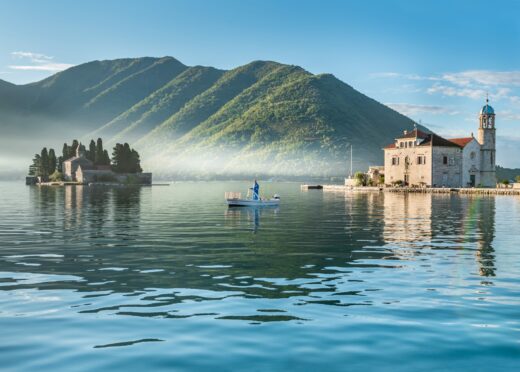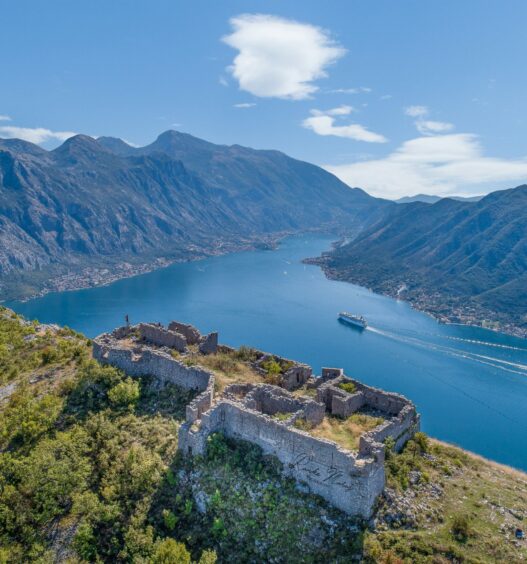
I’m in a dry dock in Porto Montenegro and I have just boarded a former Yugoslav Navy submarine which goes by the felicitous name of Hero 821.
Built in 1969, the vessel has a tiny, supremely functional interior, almost certain to induce claustrophobia. The very small bed, for instance, makes a prison-cell bunk look like a four-poster at the Ritz.
As I shudder at the minuscule living space of this echoey and unhomely craft, I’m idly imagining if the 28 ratings crammed in here used to cheer each other up by singing: “We all live in a Yugo submarine.”
Hero 821, an extraordinary example of living history, is just one of the splendid sights you can see in Porto Montenegro. Boasting 260 sunny days a year, it is a glorious spot on the Adriatic coast that is only now beginning to be discovered by British visitors.
A great place to start is the Regent Porto Montenegro, a beautiful five-star hotel constructed on the site of a former Yugoslavian-era submarine base (hence the presence of Hero 821 next door).
The hotel’s 175 gorgeously appointed rooms feature a fully equipped kitchen and – a particular joy, this – two loos. They also offer the sort of awe-inspiring views that lesser hotels would sell their concierge for.
The surrounding landscape has a spectacular, widescreen feel to it. Stunning black mountains – the clue’s in the name, Montenegro – drop straight into the sparkling Unesco-protected Boka Bay. It’s like a cross between the Norwegian fjords and the Italian lakes.
The Regent Porto Montenegro, whose carefully crafted decor is enhanced by the intriguing combination of Murano glass sculptures and plans for the vessels the Yugoslavians used to build on the site, has excellent facilities.
As well as three pools – from the first-floor infinity pool, you can gaze enviously at the super yachts moored in the marina – the hotel has access to a private beach which is only 10 minutes away by boat. The lay-out is very well thought-out, too. For example, in the middle of the courtyard grows an ancient olive tree as elegant and classy as the hotel on whose ground it now stands.
The food at the Regent Porto Montenegro’s four restaurants is top-notch as well. The truffled scrambled eggs served at breakfast, for instance, are worth crossing several mountain ranges for.
There are many hidden gems near the Regent Porto Montenegro. Take the breath-taking medieval city of Kotor. This Unesco World Heritage Site occupies an astounding location on a triangle of land hemmed in on two sides by the sea and on the other by vertiginous cliffs.
Between 1420 and 1797, Kotor was ruled by the Venetians who left a wonderful architectural legacy. Ringed by five kilometres of thick defensive walls, the city is a patchwork of eye-catching Venetian-style piazzas. It also has several fine Italianate balconies that would not look out of place in an outdoor production of Romeo and Juliet.
Another site well worth visiting is the Church of Our Lady of the Rocks, whose history is fascinating.
__________________________________
PS
Just off the main square of Kotor, you can admire the grandiose Beskuca Family Palace, where the wealthy clan resided between the 15th and 18th centuries.
It features a humongous door tall enough for a mounted horse to ride through. In those days, the thinking was: The bigger the door, the greater the status symbol.
The modern-day equivalent would be a garage sufficiently massive to house a collection of Ferraris.
__________________________________
In 1452, a fisherman claimed to have discovered an icon of the Virgin Mary on a small rock in Boka Bay as he was being rescued from a shipwreck.
As a sign of his gratitude, he pledged to construct a church on the site. Over the next two centuries, every time a fisherman passed the rock, he would throw another stone onto it. By 1630, enough rocks had been amassed to create a new island on which a church was built. To this day, passing sailors hurl rocks on the island to bless their journey.
The most astonishing object on the island is kept in the museum next to the church. The tapestry of the Virgin and Child was started by Jacinta Kunic-Mijovic in 1828.
It was an offering for her fisherman husband who had just left on a trip. She decorated the exquisite tapestry with all the goods he had brought home over the years, including gold, silver, pearl and Chinese silk. The work is extremely intricate, utilising 650 stitches per square centimetre.
Quite remarkably, over the next quarter of a century, Jacinta also wove her own hair into the tapestry. To begin with, it was brown, but by the end it had faded to grey.
There is a very sad coda to the tale, though. Not only did working for 25 years under candlelight cause Jacinta to go blind, but also her husband never returned. Speculation as to his fate still rages. Was he taken by the sea … or another woman?
Hailed as the new Croatia – minus the crowds and the cost – Montenegro is a gloriously unspoiled destination.
Before the secret gets out and the country is turned into the new European tourist hotspot, make sure you go to this idyllic corner of the former Yugo.
Regent Porto Montenegro costs from £155 per room per night, inclusive of breakfast. Visit ihg.com. Flights to Tivat: easyjet.com

Enjoy the convenience of having The Sunday Post delivered as a digital ePaper straight to your smartphone, tablet or computer.
Subscribe for only £5.49 a month and enjoy all the benefits of the printed paper as a digital replica.
Subscribe